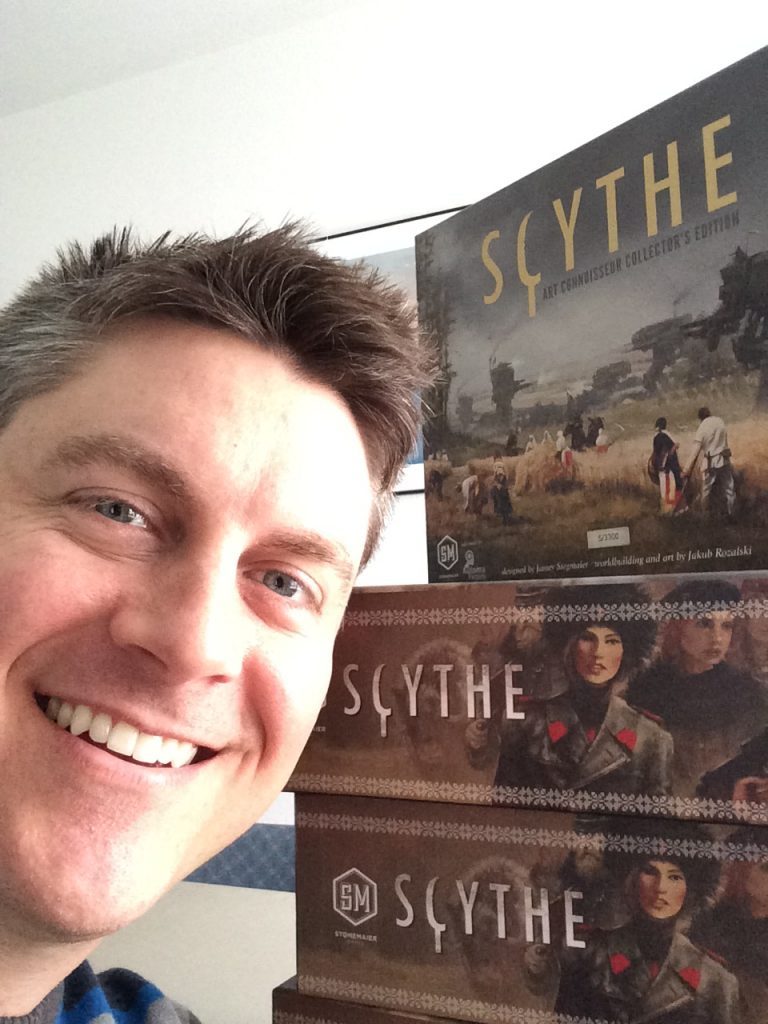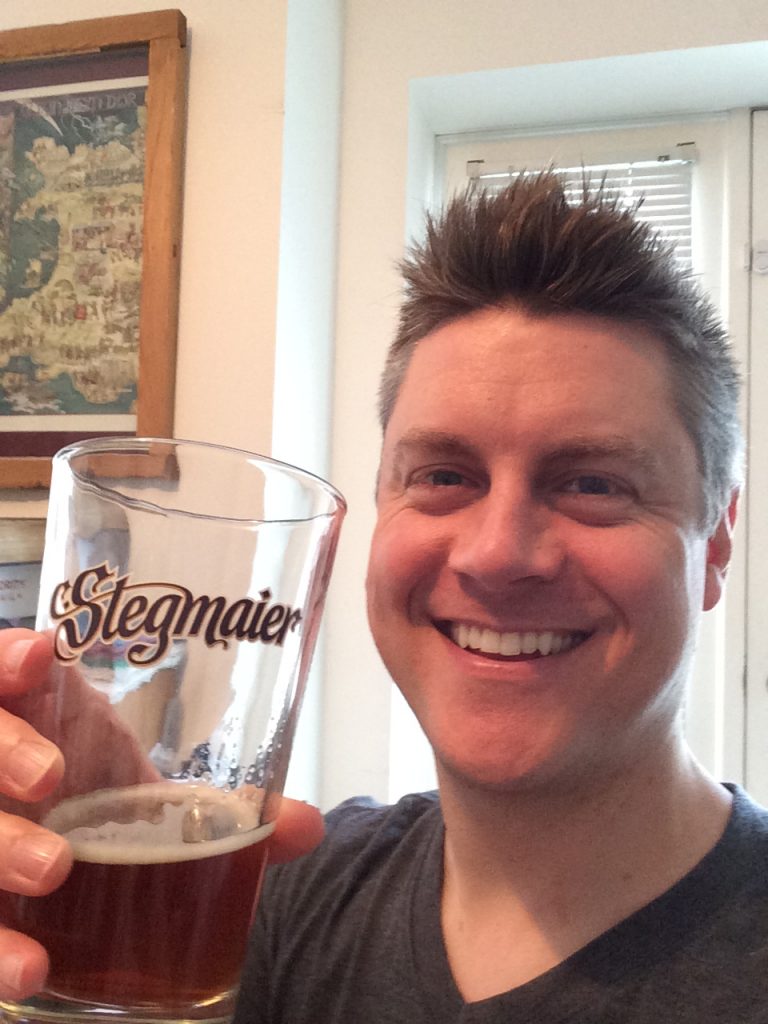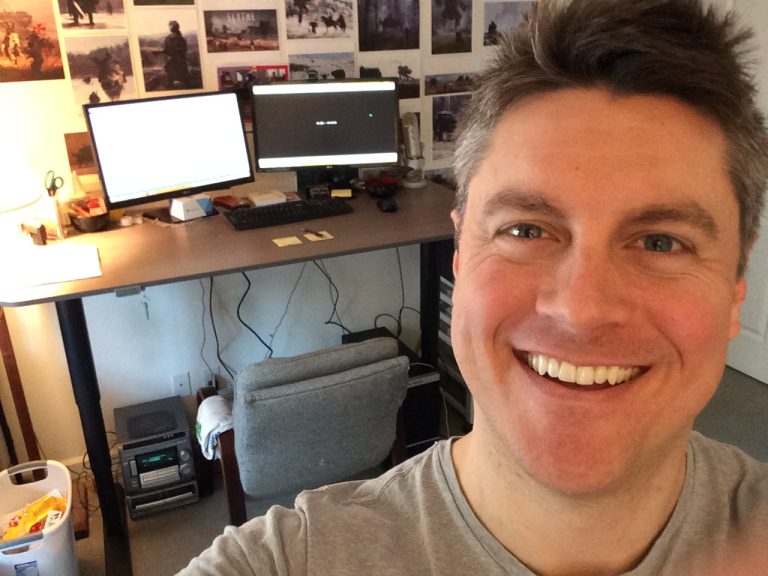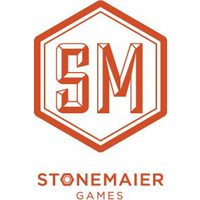Wir haben uns mit Jamey Stegmaier (Scythe, Viticulture und Euphoria) in Verbindung gesetzt. Dieser war so freundlich uns ein Interview zu geben. Erfahrt also etwas über seine Designphilosophie, wie ihn Jakub Rozalski beeinflusst hat und warum er Kickstarter den Rücken kehrt.
![]()
Dear Jamey, first of all thank you very much for doing this interview with us. We have prepared a couple of questions, feel free to answer as detailed as you like.
At first I would like to start with a little background information. Could you tell our readers a little bit about yourself, why you have decided to become a board game developer and the History behind Stonemaier games?
Where to start? I run a tabletop game publishing company called Stonemaier Games. Most of the things I do on a day-to-day basis involve operating the company itself (customer service, project management, etc), but I’m also a game designer for many of our games (Viticulture, Euphoria, Scythe, and the upcoming Charterstone). I’ve been passionate about game design since I was a child, and while I never saw it as a potential career, that changed after I successfully funded and delivered my second game-related Kickstarter, Euphoria.
What we love about Viticulture, Euphoria and Scythe is, the way you can succeed in this game depending on the strategy you use and very little is based on pure luck. What was your design philosophy behind those games and what have inspired you?
When I play games—I play a lot of games—and when I design games, I’m always looking for interesting choices, moments of joy, and flow.
I love interesting choices in games. Usually, that translates to a minimal amount of luck, but sometimes it means making the best choice based on limited options (like when deciding which visitor card to use and which part of the card in Viticulture).
I play games to have fun. Fun means different things to different people, but I’m always looking for moments of joy (or things that are getting in the way of joy). For example, at a certain point in the Euphoria design, players didn’t roll their worker dice. Instead, the dice were just a counter for your knowledge. But rolling dice is fun. I had this component that wasn’t being used for the most fun part of it. So I changed it.
The last element I’m always looking for is flow. I love games where turns flow naturally, one after the other. I think this keeps players in the “magic circle” of a game—it creates immersion. That’s why all of my games feature short, streamlined turns, and most of my games don’t involve rounds or phases. Players simply take turns until the game ends.
When you design a game, what is your main focus? Do you want to create something that is simply fun to play or what else do you have in mind? How does the consumer/fan affect your design choices?
Fun is definitely the main focus. I love clever mechanisms and immersive themes—I strive to create both—but I make final decisions based on fun.
For a long time, I designed games that I wanted to play. And I still do that—I couldn’t spend a year of my time focused on something I don’t enjoy playing. But I’ve learned that I rarely get to play the published versions of my games. When my games hit the table, it’s usually because I’m teaching them. So I’ve learned that I need to design games—or systems within those games—that make it fun and easy to teach those games.
As for the consumer/fan, some of them are playtesters, and playtester feedback often has a big impact on my designs. As for the overall market, I’m definitely affected by what people seem to love. I want to publish games that people will play a lot.
Some fans have criticized the unrealistic approach in Viticulture how “Rose” (Rosado or Reseto) is produced (mixing white with red grapes)? Some even say it’s a theme breaker. The production process is deeper, then simply a combinations of those. Well, I personally don’t mind as long it serves the gameplay. Why have you designed it that way?
In Viticulture, blush wine is actually created by mixing white and red grapes , which is exactly how some blush wine is made. This is an example of a design choice that was inspired by theme—it works that way in real life, and it also works in the game, so that’s what it is!

Your games have very nice and distinct art, can you please go into more detail on how you come up with the theme and how do you select the right art style for your games? To be more specific, how have you the discovered the works of Jakub Rozalski for Scythe? Can you please describe roughly the whole working process with Jakub from start to finish?
For most games, I start looking for an artist fairly early on. I have a long list of artists I want to work with, and BoardGameGeek makes it easy for me to discover new artists all the time.
Scythe was a bit different because the game started with art. Jakub had already started to create his 1920+ world when I discovered it. It really captured my imagination, and I approached him to see if I could design a game in that world. Through our partnership, the world evolved to include a number of different factions instead of just two. We stayed in constant contact over the next year so he could tell me if a certain mechanism wasn’t a good fit for the theme, and I could tell him if something didn’t make sense or if I needed more illustrations of a certain faction (Jakub really loves Anna and her bear, so I had to encourage him to include other characters too!). Throughout the entire process, I had a giant wall of Scythe art in my office. Whenever I was trying to make a design decision, I would look at that art and ask myself, “What would best capture the feel of this world?”
Would you say creating the art and graphics for the games are the most costly process during development? As you have described, it takes a long time and a game has to go trough lots revision and changes visually. I guess this produces lots of unforeseen expenses, which you have to finance in advance?
Other than the cost of a designer’s time, yes, art and graphic design are the largest cost leading up to a game’s production. I wouldn’t say that it’s an unforeseen expense, though. Once you get to the point that you’re ready for art, you have a pretty good estimate of the amount of art you need in the game. So at that point, it’s a fairly predictable expense.
When looking at the development cycle, how long does it take from the first Idea until the finished product? What are the steps you have to take during the whole development? How many people are involved?
Usually about 18-24 months from the first idea to receiving the first print run. A broad overview of the steps is brainstorming, prototyping, local playtesting, blind playtesting, art/design, printer proofs, manufacturing, freight shipping. Thousands of people are involved in the process, with the biggest groups being the people who manufacture the game and the blind playtesters.
During development, do you focus on cost control early on or do you put vision and ideas first before even thinking about cost? I can imagine you don’t want to end up with a product, which is superb but too expensive to produce. How do you manage this process?
As a publisher, I’m always thinking about cost. While there is no such thing as something that is too expensive to produce, there is the possibility of something having too high of an MSRP to be marketable. I try to get quotes on specific components from our manufacturer, Panda, throughout the process.
Well, lets say you have a specific idea for some components you would like to use for a game, for example, miniatures. Do you take the risk, invest extra money in developing these or will you compromise and seek for different/cheaper solutions or even scrap the idea to reduce cost and subsequently price the game cheaper for the consumer? In your opinion, what is the maximum price an average consumer would be willing to pay for a game?
I think it really depends on the game. If the component is absolutely crucial for the game to be fun, I’ll find a way to make it work. If it’s not as important, I’ll cut it. For my heavier games with more components, I usually aim for a $60 MSRP, which I think is a fair, appealing price to an average consumer for game with a large number of high-quality components. But that target sometimes needs to change, as it did for Euphoria ($70 MSRP) and Scythe ($80 MSRP, though it really should be $90 MSRP).
Over the course of the history of Stonemaier Games, what was your greatest success you have achieved and what was your biggest failure so far?
I gauge success by whether or not people are finding joy in our games. It’s hard to quantify that or say that people are finding more joy in one game than another—it depends on the people. If any of our games makes someone happy, that’s the greatest success to me.
As for my biggest failure…that’s hard to say. I mean, I’ve made a lot of mistakes, many of which I detail on my blog. But we haven’t had an epic failure for any of our products yet. Honestly, the things that haunt me are times when I treated someone poorly instead of with love, compassion, and respect. Some people make it really difficult to do that, but some are just passionate, and sometimes it’s hard for me to tell the difference (and they both still deserve a measure of love and respect).

Let’s look at your commercial successes. Which game in your portfolio sold best so far. How many copies in total, has Stonemaier Games shipped worldwide (roughly) to date?
In terms of all products we’ve sold (including accessories like metal coins), we’ve sold a total of about 300,000 units. Our current circulation of Scythe is 52,000 games, making it our best-selling game (Viticulture is a close second).
What to expect of your next game Charterstone? How is the project progressing and will you aim for an early or late 2017 release? What are your expectations towards sales figures for this one?
I’m aiming for a 2017 release—I can’t really say more than that, as I don’t know. Well, I know it won’t be an early 2017 release. I know that for sure. I’m not really thinking about sales figures at this point—I just want to make a good game that people will enjoy.
As for Charterstone you have announced that you won’t do a Kickstarter for this project, despite the great success you had with Scythe ($ 1,8 Mio raised). Why have your decided to take a different approach this time? Will you abandon crowdfunding for good?
Yes, I don’t see Stonemaier Games returning to Kickstarter or any type of direct pre-order. I’m grateful for my experiences on Kickstarter and the impact they’ve had on my company, but it takes an incredible amount of time to plan for, run, execute, and fulfill a Kickstarter campaign. I’m at the point where I’d rather Stonemaier use our resources in a different way. Also, I think distributors and retailers do a great job of accomplishing what I’ve done on Kickstarter, and I want to enable them to continue to do what they do best without taking away their customers.
There are other reasons too, of course, but I’m still figuring out how to put words to them.
We love the tokens, it enhance the gaming experience so much. Please tell us about your thoughts and intentions when you first toyed with this idea, designing those tokens? Do you plan to do more in future?
I’m glad you like the tokens! They were really never part of our business plan. They started as a cool enhancement for the Euphoria Kickstarter, but I made the mistake of making those specific tokens “Kickstarter exclusives,” meaning that I couldn’t sell them to anyone after the campaign. But people wanted them. So I decided to make new versions of the tokens that weren’t part of the “exclusive” promise, and we had so much fun with them that we made more. At this point we have over 50 types of special tokens. Currently, I have plans for one specific token (a token found in Charterstone that we don’t already make), and we recently released our new animal tokens, but other than that I don’t have any other plans.
North America and Europe are the biggest markets for table top games. Your focus lies in North America, how important are foreign markets like Germany for you? What is your marketing strategy outside the USA? Have you ever looked into the Asian markets (Japan, China etc.) as potential sales market for your products?
Our focus and reach are worldwide. Every region, every country. We have Chinese, Japanese, and Korean versions of our games. Same with South Africa and Europe. And we work directly with distributors in every region. Like I said, my mission is to bring joy to tabletops around the world—that means the entire world. ?
For the German audience reading this, I’ve really enjoyed working with Feuerland, and I intend to continue to do so.
Speaking of Feuerland, can tell us a little bit about how you came in contact and why you have decided to work with them for Viticulture? How do you select distributors? Are you pro-actively looking for partners or do they approach you?
If I remember correctly, I was introduced to Frank at Feuerland by Uwe Rosenberg. Uwe helped me design the Moor Visitors expansion to Viticulture, and he was the one who recommended that we make the Viticulture Essential Edition in both English and German.
For distributors (companies that sell our games to retailers), I’m open to pretty much any company. I’m more selective about production partners like Feuerland. They typically contact me to say that they want to make one of my games in their language, and we talk about it (quantity, cost, etc). Usually, they seem like great people to work with, and I give them a chance. Sometimes it becomes clear after one game that they don’t meet deadlines for translations or payments and they don’t communicate well, but that’s pretty rare, so I often work with the same international partners multiple times.
Recently we did an interview with a small German game publisher “Schwerkraft Verlag”. Mr. Reuter told us about the difficulties with one of his projects “Mare Nostrum”. Production delays, insufficient quantities supplied to fulfill Kickstarter backers; bad communication with manufacturer has severely damaged the company. Have you encountered similar problems with your projects so far, if yes how have you dealt with it?
I work with Panda, and their communication is excellent. They’ve never had a delay that they didn’t anticipate or make up for, and they’ve made every game they promised to make. So no, fortunately, I’ve never experienced the problems Mr. Reuter mentioned.
For a small company, every mistake will impact the company financially, how do you manage risk in your day-to-day business? How do you secure the quality of your supply chain? If I am informed correctly, you have worked closely with Panda Games for all of your projects so far? Can you describe the process how you work with Panda on a project?
A big part of mitigating risk is estimating the correct size of print runs. If I make too many games, I have cash tied up in inventory that I’m not selling. If I make too few games, many people (and distributors/retailers) are unhappy because they can’t get what they want. I still have a lot to learn about making the correct amount in each print run.
With Panda, I get quotes from them throughout the design/development process. When a game is ready, my graphic designer sends Panda the final files, and Panda reviews them and usually notes a few small changes. Then Panda spends a few months manufacturing all of the pieces (some of which they outsource to other factories that they’ve carefully vetted). At certain points throughout the process, I’ll get samples of components or even the entire game so I can approve it before moving forward. Finally, Panda will assemble everything and send it to me.
As an entrepreneur, what advice would you give to startups in how to run a successful business for table top games?
Budget well, create a community, find the fun in your games, and get the best art and graphic design you can afford.
If you look 5 years into the future, where do you see yourself and Stonemaier Games? What are the greatest challenges you and your company has yet to face? Will you still focus more on the development of brand new games or move more toward publishing games you love like you’ve done with “Between two Cities”?
I usually look about 1-2 years in the future—5 years is a long time! I think we’ll try to continue the current trajectory: Publish 1 big new game a year, maybe 1 smaller one, and a few expansions/accessories. I’m open to those games being from other designers. I also hope to continue to reprint our current games and find new international partners for localized versions of them.
As for the greatest challenges we have yet to face, I’m not sure what they are yet, but I look forward to facing them.

You have stated, running Stonemaier games is a 24/7 job for you. Do you still have time to play other games? What are your all time favorites and why? Do you have a favorite designer?
Oh yes, I play a lot of other games—I have a YouTube channel devoted to talking about them. I host a weekly game night every Wednesday, and I usually play games on Saturday, and lately we’ve been playing campaign games every Monday.
My current Top 10 list is:
1.) Castles of Mad King Ludwig
2.) Isle of Skye
3.) Terra Mystica
4.) Tzolk’in: The Mayan Calendar
5.) T.I.M.E. Stories
6.) Blokus
7.) A Fake Artist Goes to New York
8.) Patchwork
9.) Telestrations
10.) Burgle Bros
For more details, you can read here, and a few of my favorite designers are Rob Daviau and Alexander Pfister.
We ask this questions to everyone we have interviewed so far. You are in hell and your punishment is to play one game over and over again, which game would drive you crazy and why?
I don’t think any game would have that impact on me, because if it was a game I really didn’t like—say, a game with no interesting choices—I would just change the rules and play it differently.
Any final thoughts you would like to share with the German readers?
My family came from Germany 160 years ago—you can probably tell this by my last name, Stegmaier. So it’s an honor for me to carry on the tradition of great German board games here in St. Louis. Thank you for that opportunity!
Thank you so much for taking your time to answer our questions. We wish you all the best and lots of success for the future. We are looking forward to Charterstone!

